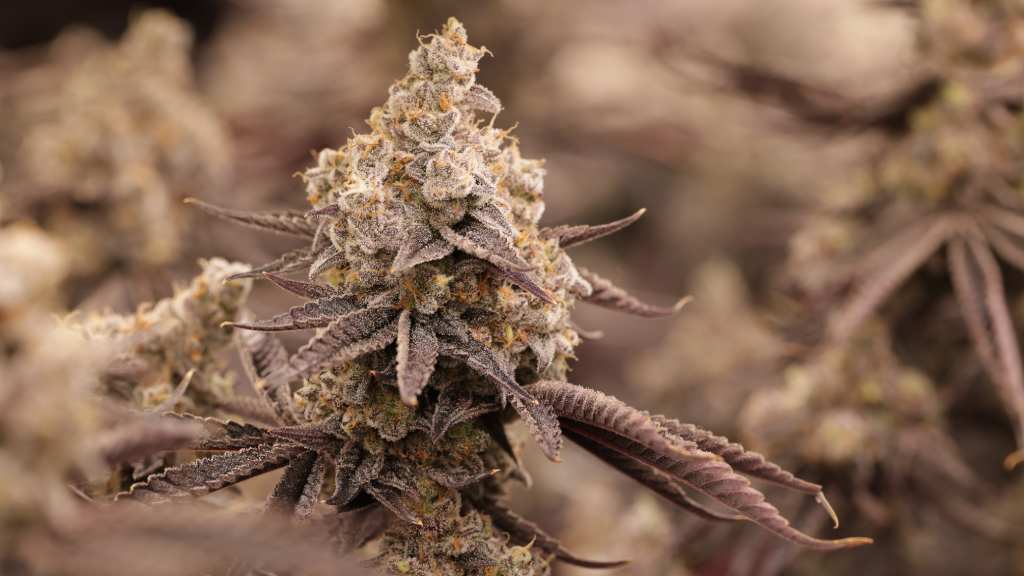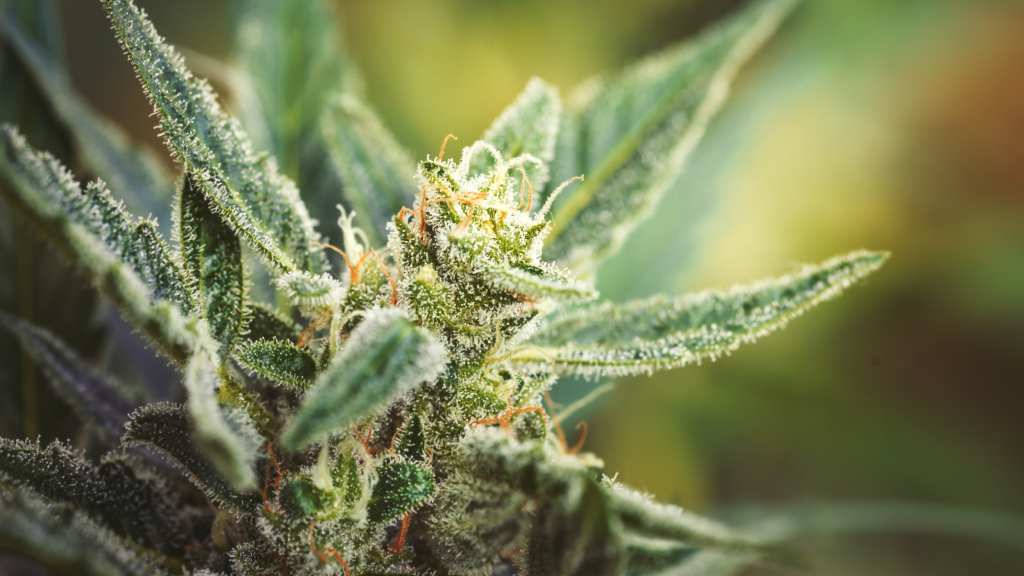The glorious cannabis plant contains around 540 chemical substances. Many people are now familiar with the most popular cannabinoids like THC and CBD, but there are well over 100 cannabinoids that each boast their own unique health benefits. With an increasing amount of attention to the other cannabinoids, researchers are now exploring major cannabinoids that aren’t as well-known, like CBN or CBG.
Join your friendly neighborhood Sensory Dispensary as we learn more about these top cannabinoids.
Cannabinoids Basics
First, it’s important to discuss what cannabinoids are and why they are such a crucial component of the cannabis plant.
Cannabinoids are chemical compounds that can interact with the body’s endocannabinoid receptors – special chemical receptors shaped to receive cannabinoids of all types. The body’s own endocannabinoid system (ECS) is a series of these receptors, located in the brain, nervous system, and places throughout the body, that appears to send chemical messages dealing with important body functions, like sleep, mood, hunger, and more. When cannabinoid compounds interact with these receptors, they can change those chemical messages and have effects on sleep, mood, and other ECS activities.
Cannabinoid Categories
There are three main categories of cannabinoids:
- Phytocannabinoids – these are the naturally occurring cannabinoids found in cannabis resin, stalks, seeds, flowers, and leaves.
- Endocannabinoids – The human body is capable of producing its own cannabinoids designed especially to interact with cannabinoid receptors. These are called endocannabinoids.
- Synthetic cannabinoids – More recently, lab-created cannabinoids like prescription medications have been emerging. These synthetic compounds interact with the human endocannabinoid system similarly to phytocannabinoids.
Cannabinoids and Cannabis Legal Status
The terms cannabis and marijuana are often used interchangeably, but there are important differences between the two. Legally, cannabis refers to all products from the Cannabis sativa L plant. Marijuana is usually used to describe the parts of the plant with significant amounts of THC (the psychoactive cannabinoid that leads to a high) – namely, the cannabis flower. Cannabis plants with under 0.3% THC are classified as industrial hemp under US law. Thus, cannabinoids are the very basis for the legal status of cannabis in the US.
Cannabinoid Effects
One important characteristic of cannabinoids are the psychoactive and therapeutic effects they can have. Cannabinoids either chemically bind with or alter the way other cannabinoids bind with endocannabinoid receptors. The Entourage Effect refers to the intricate and not fully understood interaction among cannabinoids and other natural compounds found in cannabis, like terpenes, flavonoids, and more. These components seem to complement each other, acting synergistically to cause more holistic effects.
This phenomenon is often cited to elucidate how cannabis can alleviate pain. While research continues, it’s evident that cannabinoids have clear advantages when they collaborate rather than act alone. In our guide to Cannabinoids, we’ll be exploring several phytocannabinoids, like CBN, CBG, and CBGA. Each is known to deliver unique health benefits.
CBN
Cannabinol (CBN) is a mild cannabinoid produced in the cannabis flower. It is derived from the cannabis plant’s psychoactive cannabinoid precursor, tetrahydrocannabinolic acid (THCA). However, it is only very mildly psychoactive, if at all. Due to its origin as a product of THCA oxidation, CBN is typically found in older cannabis that has been exposed to sunlight and allowed to oxidize.
CBN has many known benefits, which include anti-inflammatory, antibacterial, appetite suppressant, and neuroprotective properties. It also shows promise as an effective sleep aid.
CBG
Cannabigerol (CBG) is sometimes called the “mother cannabinoid” because its acid form, CBGA, is the precursor to many other cannabinoids. It is found in smaller quantities than CBD and THC, but it is gaining acceptance as a treatment for certain health conditions.
CBG may have anti-inflammatory, neuroprotective, and antibacterial properties. This cannabinoid is also being studied for potential therapeutic effects for glaucoma, inflammatory bowel disease, and certain types of cancer.
CBG can reduce eye pressure, fight inflammation, and act as an antioxidant. It also has potential benefits for anxiety, brain protection, skin health, and appetite stimulation.
CBGA
Research into the potential therapeutic effects of CBGA itself is still in its early stages, but it’s believed to possess anti-inflammatory and neuroprotective properties, among others. As scientists continue to explore the diverse array of compounds present in cannabis including CBGA, they may uncover even more about its potential benefits and applications.
A study by the National Institutes of Health found that CBGA can protect the kidneys in mice from damage caused by different conditions. CBGA prevented kidney inflammation and urine output reduction in mice treated with cisplatin (a chemotherapy drug known to harm the kidneys). The use of CBGA in the study also prevented weight loss and reduced kidney scarring. These NIH findings suggest that CBGA and CBD could be promising for kidney health.
CBDA
Cannabidiolic acid (CBDA) is a CBD precursor found in fiber and seed-oil hemp plants. Its health benefits have been overshadowed by the scientific focus on CBD. CBDA binds to different receptors than CBD and inhibits enzymes that influence the endocannabinoid system (ECS). Emerging research indicates that CBDA may:
- Reduce inflammation
- Alleviate nausea and vomiting (especially post-chemotherapy)
- Affect serotonin levels (which influences sleep, mood, and appetite)
CBDA is being studied for its potential as an anti-inflammatory, antiemetic, anti-convulsant, and anti-cancer agent. There have been limited efforts to research reliable purification methods. Ongoing research is exploring whether CBDA might have anti-inflammatory properties similar to those of NSAIDs.
THCV
THCVA (tetrahydrocannabivarin acid) is a precursor to THCV (tetrahydrocannabivarin). It shares similarities with other cannabinoids derived from the raw cannabis flowers. Early research suggests that THCVA may offer pain relief and reduce inflammation.
Studies indicate that THCV may also help reduce overeating and obesity, offering potential benefits for weight management. THCV is currently being investigated for its potential to alleviate symptoms of PTSD, degenerative neurological diseases like Alzheimer’s, and mental health conditions like depression and anxiety.
In studies that involved rodents, THCV was successful in decreasing appetite, increasing satiety, and regulating metabolism, suggesting it could be a useful tool for weight loss, as well as management of obesity and type 2 diabetes.
CBC
CBC (cannabichromene) is a lesser-known cannabinoid found in cannabis. It is not as well-studied as THC or CBD, but early research shows potential therapeutic benefits. One study by the NIH found that CBC (a key component of marijuana that is non-psychoactive) can normalize intestinal movement during inflammation in healthy animals. This protective effect of CBC on the intestines was linked to changes in certain receptors and channels.
These findings are important because intestinal movement problems are common in inflammatory diseases. Many current treatments often cause constipation, but CBC offers a potential alternative. Also, since CBC affects certain receptors and channels, it might have benefits for other conditions like intestinal inflammation, pain, and cancer.
CBD
While CBD (cannabidiol) is a fairly commonly discussed, used, and researched cannabinoid, more research is needed to fully understand its properties and benefits. However, studies have shown that, much like other cannabinoids, it helps reduce inflammation. Moreover, one study demonstrated that CBD can help treat arthritis in rats. Hemp-derived CBD is legal in the United States, making it a popular ingredient in many products, from lotions to supplements.

Taking minor cannabinoids like CBN, CBG, CBGA, CBDA, THCV, and CBC can offer various potential benefits. It is essential to approach their use with caution and knowledge.
Here are some tips:
Check the Research
Before trying any supplement, medication, or cannabinoid, take time to research the substance’s potential effects, benefits, and risks. It is important to understand how CBN, CBG, or another cannabinoid interacts with the body’s endocannabinoid system. If you are currently taking medications, understanding how the cannabinoid interacts with the existing medication is crucial.
Start Slow
Ideally, you should begin using the new cannabinoid under the advice of a professional or business that has extensively researched cannabis products. Begin with a low dose of the cannabinoid and gradually increase it as needed. This helps you to adjust the dosage and monitor its effect on your body without becoming overwhelmed.
Choose Reputable Sources
Develop a relationship with the friendly cannabis experts at an Ivy Hall dispensary near you. It is always better to speak with someone in person than rely on online information. While you’re here, look for products that are straightforward with their testing and the associated results. As mentioned, a cannabis expert can help you choose the best product for your needs.
Carefully Consider Your Delivery Method
Cannabinoids can be consumed in various forms. Popular options include oils, capsules, edibles, topicals, and even flower. Choose a delivery method that aligns with your preferences. If you’re looking for systemic effects, oral ingestion may be preferable. Topical application may be suitable for localized relief.
Monitor Your Response
Pay attention to how your body responds to the new cannabinoids. Keep track of the effects and write down changes in symptoms. Note side effects and adjust your dosage or delivery method accordingly.
Be Patient
Minor cannabinoids can take some time to produce noticeable effects. This can be especially true if you are using them to treat symptoms of chronic conditions. It will take time for the therapeutic cannabinoids to build up in your system. After a certain period of time, you can evaluate their long-term effects.
When it comes to taking cannabis products, it’s important to remember that what works for one person may not have the same effect for another. Pay attention to your body’s responses and consider keeping notes about your health and wellness journey.
Exploring Popular Cannabinoids FAQs

Scientific research into the health benefits of cannabinoids is ongoing, but there are promising health benefits to many lesser-known cannabinoids. When searching for information about these and other hemp products, it is important to stick with reliable sources.
What Is a Cannabinoid?
Cannabinoids are natural compounds found in the cannabis sativa plant known to interact with the human endocannabinoid system to produce or modulate bodily effects. Approximately 160 have been identified thus far, with approximately 140 found in the cannabis plant. THC and CBD are the most well-known, while many others also provide benefits.
Cannabinoids are one of several types of compounds found in the cannabis plant, in addition to terpenes and flavonoids. They can work together synergistically to interact with the ECS and help with sleep, inflammation, appetite, and more.
Do All Cannabinoids Get You High?
No. In fact, the majority of cannabinoids are non-psychoactive, meaning they do not get you high. However, both psychoactive and non-psychoactive cannabinoids may be capable of delivering therapeutic benefits. Some are anti-inflammatory, while others can relieve stress and anxiety.
Of all the cannabinoids, the one best known for delivering a high is THC. Delta-8-THC can deliver a mild high.
Which Cannabinoids Have Anti-Inflammatory Properties?
Many people take CBD and THC for their anti-inflammatory properties. Other cannabinoids like CBG, CBC, THCV, CBDA, and CBGA are also known for reducing inflammation by interacting with the endocannabinoid system.
Their properties may offer significant relief for individuals grappling with inflammatory bowel disease and other conditions characterized by chronic inflammation, such as arthritis or dermatitis.
What Is the Endocannabinoid System?
Every person has an endocannabinoid system (ECS) with specialized receptors in the brain, digestive system, organs, muscles, and skin. The system was discovered in the early 1990s. The ECS and its chemical messaging capabilities are influenced by naturally produced endocannabinoids and cannabinoids derived from cannabis.
The system helps regulate appetite and digestion, metabolism, pain, inflammation and immune responses, mood, learning, motor control, sleep, and the cardiovascular system, among other important functions.
The ECS includes CB1 and CB2 receptors, which regulate various body functions and prevent other substances from affecting these functions. Research continues to explore the ECS’s role in health.
How Do Cannabinoid Receptors Work?
Cannabinoid receptors play a crucial role in allowing cannabinoids to help the body heal. Our bodies have two main types of cannabinoid receptors: CB1 and CB2. THC binds to both CB1 and CB2 receptors, affecting the brain and body.
CBD interacts with the ECS in a more complex way and does not bind to CB1 or CB2 in the same manner as THC. The interaction between cannabinoids and the body’s receptors is likely what allows these cannabis products to deliver benefits for sleep, pain relief, reduced anxiety, and enhanced concentration.
What Is the Entourage Effect?
The Entourage Effect refers to the complex and not fully understood relationship between cannabinoids and other natural compounds in cannabis like terpenes and flavonoids. They appear to work synergistically to modify the response of the ECS receptors to chemical messages sent within the body. The entourage effect is often used to explain how cannabis can help relieve pain, provide relaxation, and more. Research is ongoing, but scientists already know that there are clear benefits to cannabis compounds working together rather than in isolation.
What Is Tetrahydrocannabivarin Acid?
Tetrahydrocannabivarin Acid (THCVA) is a cannabinoid precursor found in cannabis plants. It is non-psychoactive and does not deliver a “high” as THC does.
When cannabis is exposed to heat through processes like smoking, vaping, or cooking, THCVA decarboxylation (loses a carboxyl group) becomes THCV. This cannabinoid has gained attention for its therapeutic benefits, which include appetite suppression, potential aid in weight management, neuroprotection, and anti-inflammatory properties. THCVA’s role as a precursor to THCV highlights the cannabinoid’s importance in ongoing cannabinoid research.
Find the Right Cannabinoid By Shopping at Ivy Hall

Ivy Hall is more than a chain of boutique dispensaries. We are a trusted source of information about cannabis and how cannabinoids can be used to treat symptoms and ailments. Whether you follow our blog or speak to us in person, you can rely on our team to provide accurate and useful information about using cannabis products.
We love answering questions about cannabis products. Reach out to our team online or visit your local Sensory Dispensary and a knowledgeable team member will help you find the answers you need.
Resources:
- National Center for Complementary and Integrative Health (NCCIH). National Center for Complementary and Integrative Health. (n.d.). Cannabis (Marijuana) and Cannabinoids: What You Need to Know. https://www.nccih.nih.gov/health/cannabis-marijuana-and-cannabinoids-what-you-need-to-know#:~:text=How%20many%20cannabinoids%20are%20there,other%20cannabinoids%20have%20been%20identified.
- Aya Khouchlaa, Sara Khouri, Ahmed Hajib, Ikrame Zeouk, Smail Amalich, Soukaina Msairi, Naoual El Menyiy, Chaimae Rais, Manal Lahyaoui, Asaad Khalid, Ashraf N. Abdalla, Salma E. Ibrahim, Nasreddine El Omari, Bey Hing Goh, Yatinesh Kumari, Sang Loon Tan, Abdelhakim Bouyahya, Health benefits, pharmacological properties, and metabolism of cannabinol: A comprehensive review, Industrial Crops and Products, Volume 213, 2024, 118359, ISSN 0926-6690 https://www.sciencedirect.com/science/article/pii/S0926669024003364
- Kogan NM, Lavi Y, Topping LM, Williams RO, McCann FE, Yekhtin Z, Feldmann M, Gallily R, Mechoulam R. Novel CBG Derivatives Can Reduce Inflammation, Pain and Obesity. Molecules. 2021; 26(18):5601. https://doi.org/10.3390/molecules26185601
- Formato, M., Crescente, G., Scognamiglio, M., Fiorentino, A., Pecoraro, M. T., Piccolella, S., Catauro, M., & Pacifico, S. (2020). (‒)-Cannabidiolic Acid, a Still Overlooked Bioactive Compound: An Introductory Review and Preliminary Research. Molecules (Basel, Switzerland), 25(11), 2638. https://doi.org/10.3390/molecules25112638
- Abioye, A., Ayodele, O., Marinkovic, A., Patidar, R., Akinwekomi, A., & Sanyaolu, A. (2020). Δ9-Tetrahydrocannabivarin (THCV): a commentary on potential therapeutic benefit for the management of obesity and diabetes. Journal of cannabis research, 2(1), 6. https://doi.org/10.1186/s42238-020-0016-7
- Calapai, F., Cardia, L., Esposito, E., Ammendolia, I., Mondello, C., Lo Giudice, R., Gangemi, S., Calapai, G., & Mannucci, C. (2022). Pharmacological Aspects and Biological Effects of Cannabigerol and Its Synthetic Derivatives. Evidence-based complementary and alternative medicine : eCAM, 2022, 3336516. https://doi.org/10.1155/2022/3336516
- Suzuki, S., Fleig, A., & Penner, R. (2023). CBGA ameliorates inflammation and fibrosis in nephropathy. Scientific reports, 13(1), 6341. https://doi.org/10.1038/s41598-023-33507-2
- Izzo, A. A., Capasso, R., Aviello, G., Borrelli, F., Romano, B., Piscitelli, F., Gallo, L., Capasso, F., Orlando, P., & Di Marzo, V. (2012). Inhibitory effect of cannabichromene, a major non-psychotropic cannabinoid extracted from Cannabis sativa, on inflammation-induced hypermotility in mice. British journal of pharmacology, 166(4), 1444–1460. https://doi.org/10.1111/j.1476-5381.2012.01879.x
- Oláh, A., Tóth, B. I., Borbíró, I., Sugawara, K., Szöllõsi, A. G., Czifra, G., Pál, B., Ambrus, L., Kloepper, J., Camera, E., Ludovici, M., Picardo, M., Voets, T., Zouboulis, C. C., Paus, R., & Bíró, T. (2014). Cannabidiol exerts sebostatic and antiinflammatory effects on human sebocytes. The Journal of clinical investigation, 124(9), 3713–3724. https://doi.org/10.1172/JCI64628
- Hammell, D.C., Zhang, L.P., Ma, F., Abshire, S.M., McIlwrath, S.L., Stinchcomb, A.L., & Westlund, K.N. (2016). Transdermal cannabidiol reduces inflammation and pain-related behaviours in a rat model of arthritis. European Journal of Pain, 20(6), 936-948. https://doi.org/10.1002/ejp.818
